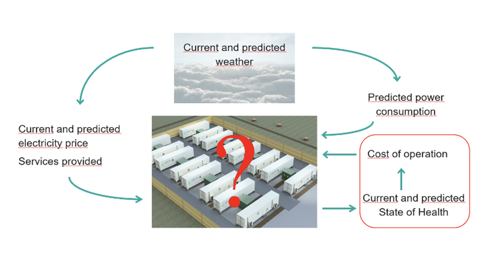Optimal usage and properties of 2nd life batteries for energy storage

Second life batteries are batteries that have ended usage in their first application but are in good enough condition to allow a second application. With the expected electrification of the transport sector, there will be very large quantities of such 2nd life batteries of highly different degree of ageing, properties and expected remaining lifetime. The abundance, their short response-time, and low energy and power density requirements, make grid applications of battery energy storage systems (BESS) with 2nd life batteries highly interesting. Examples of potential applications are frequency control, energy balancing to compensate for variations in renewable energy sources, and power peak shaving.
Research questions
To promote employment of 2nd life BESS we need to operate them in the best possible way. However, optimal operation of battery energy storage systems (BESS) in the grid is a truly challenging control problem as it has to take into account:
- bidding for multiple services to the grid (frequency control) with uncertain remunerations and different timeframes
- uncertain forecasts, i.e. weather conditions and consumer loads, that will affect future prices over a given time-horizon
- energy arbitrage, i.e. charging/buying at low prices and discharging/selling at high prices
- operating costs, including installation and replacement of battery packs.
This is yet an unsolved problem, for which this project aims to find a solution.
One economically particularly important element that has either not been included, or has been oversimplified in previous work, is the cost of battery ageing and how this ageing is affected by the usage. In the optimisation mentioned above, a prediction of the cost will depend on the predicted ageing of the batteries. No two battery packs are identical, and for second life batteries any initial differences will be amplified and depend on previous usage in their first life, for which there is very limited information. Consequently, we need to develop self-adapting ageing models that for each individual battery adapt to the observed decrease in energy and power capabilities. This is the second focus area of this project.
In addition, the project also aims to:
- show how, for given available battery packs of different properties and conditions, the packs should be configured. For example, how should packs be sorted, and should they be connected in parallel on the DC or AC side of the converter(s)?
- identify key parameters that determine the success of a BESS installation.
Involved in the project
Benedick Lees, PhD student
Torsten Wik, co-supervisor, AC
Changfu Zou, main supervisor, AC
Oliver Ingvall King, Volvo Energy (replacing Niklas Thulin)
Faisal Altaf, Co-supervision, Volvo GTT
Hanna Persson, CTO, BatteryLoop
Leo Flyttström, analysis, BatteryLoop
Partners
Chalmers, Volvo Energy, Repono, Swedish Energy Agency